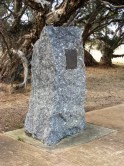Quick Search
Browse:
Town Info:
John Boyle O’Reilly
- Categorized in: Attractions

John Boyle O’Reilly Memorial Monument – Buffalo Rd – 11.6km Buffalo Road – 11.6 km.
In 1803 Lieutenant de Freycinet on board the ‘Casuarina’ sighted a rocky point which was part of what is known now as Koombana Bay. On entering the Bay he discovered an inlet which he named ‘Leschenault’ after the expedition’s botanist. John Boyle O’Reilly was one of 62 Irish Political prisoners among 279 convicts who arrived at Fremantle in 1868. He was a member of the Fenian Movement, an organisation dedicated to achieving an independent Irish Republic.
John Boyle O’Reilly escaped from this area whilst working as a member of a convict road crew near Bunbury. He hid in the dense peppermint woodland with the help of a local family. John Boyle O’Reilly made his escape aboard an American Whaler, the ‘Gazelle’ on 3 March 1869. Before settling in Boston he assisted 6 Fenian political prisoners in their escape from Fremantle Prison aboard the ‘Catalpa’. He became a well known humanitarian, poet, writer and orator. A granite monument erected to John Boyle O’Reilly stands at the northern entry to the Leschenault Peninsula Conservation Park.
Following European Settlement the Peninsular was mostly used for stock grazing. In 1838 Thomas Little purchased 741.4 hectares on Leschenault Peninsula on behalf of Charles Prinsep, and named the homestead Belvidere in honor of the Prinsep mansion in Calcutta. Little managed the property to raise horses and cattle for the Indian Army. In the late 1960s and throughout the 1970s, Belvidere became a commune for alternative lifestyler’s, with up to 14 houses. A granite monument to; John O Reilly, Irishman, soldier, convict, poet, author and lecturer.
John Boyle O’Reilly Wetland Trail – Leschenault Peninsula Conservation Park – Australind
Length: 1km return – Surface: Bitumen and Boardwalk
Easy – Users: Walkers, Prams, Wheelchairs
Facilities: Information Shelter, Tables, Toilets.
Learn more about the plants and animals of this park as you meander through Tuart, Peppermint and Paperbark trees. At the information shelter, discover how the Irish convict John Boyle O’Reilly made his daring escape into the bush here from a ship named the Gazelle in 1869.
Other Historical Plaques
Benjamin & James Piggott – near Shire Office in front of Library, early pioneers.
Australind State School – 1.4 km Cathedral/ Scenic Drive
Catholic Church Site- Circa 1870- 1970 2.4km Cathedral Scenic Drive
Parkfield School – 10 km – Buffalo Road, just past the stand of trees.
